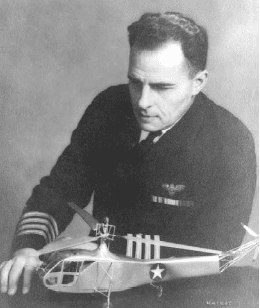
CDR William J. Kossler USCG, a member of the Inter Agency Board, established to research and develop rotary-wing aviation, was convinced that the helicopter was the rescue vehicle of the future and would fulfill the future needs of the Coast Guard. As a member of this board he attended a very impressive flight test demonstration conducted by Sikorsky Aircraft Corporation on April 20, 1942. The demonstration caused great excitement at Coast Guard Headquarters resulting in a recommendation by CDR. Frank A. Leamy, the Aviation Operations Officer that several Sikorsky VS helicopters be purchased for training and experimental development. CDR Kossler advocated the purchase of three but neither the Engineer-in-Chief nor the Assistant Commandant was convinced. They stated that the acquisition of helicopters was not essential to the war effort and without the support of these two officers, next in rank to the Commandant, the future looked bleak for Coast Guard involvement with the helicopter.
The Helicopter as an Anti-submarine Weapon:
Kossler, although disappointed, was not about to give up. This was the period of an intensive and effective German submarine campaign off the east coast of the United States. He reasoned that the helicopters vertical take-off capability would enable it to operate from a merchant ship underway and provide protection from submarines. A series of events – some manipulated and others serendipitous – took place that would result in the development of the helicopter by the U.S. Coast Guard.
The Coast Guard air station at Brooklyn, New York was across the sound from Bridgeport, Connecticut which was the location of Sikorsky Aircraft. The Commanding Officer of the Brooklyn air station was CDR W.A. Burton who had accompanied Kossler on the first helicopter flight test demonstration. His Executive Officer was LCDR. Frank Erickson. Kossler had spent time with Erickson during a trip to Hawaii. The two men discussed search and rescue techniques and after Kossler’s return to Washington, as the chief of the Aviation Engineering Division, the two men continued to exchange ideas. In the middle of June Kossler stopped by the air station and discussed the helicopter situation with Erickson. A few days after the visit, Kossler’s assistant, LT. Bill Haley arrived at the air station. During lunch he casually mentioned that he had an appointment with Mr. Igor Sikorsky and wondered if anyone would care to fly him to Bridgeport. Erickson volunteered. Erickson met Igor Sikorsky and Michael Gluhareff, his Chief Engineer, and spent hours discussing the possibilities of the helicopter. Sikorsky put on a very convincing flight demonstration during which he repeatedly landed the helicopter within inches of a given spot. Erickson later stated that he did not realize that this whole sequence of events had been arranged ahead of time for his benefit.
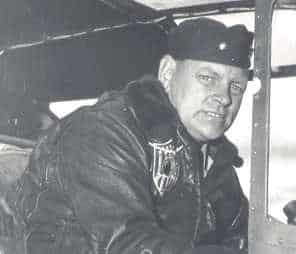
Erickson immediately started drafting a report for headquarters. The rescue capabilities of the helicopter were obvious but being aware of Kossler’s setback he submitted a proposal for the development of the helicopter as an anti-submarine weapon. In the proposal he laid out specifics as to armament, aircraft capabilities, and utilization. He further stated that Coast Guard aircraft were presently flying anti-submarine patrols and it would be a natural for the Coast Guard to develop the anti-submarine capabilities of the helicopter. Burton strongly endorsed Erickson’s proposal. Burton’s endorsement pointed out that the Army had demonstrated its belief in the value of the helicopter by contracting for a number of the present models. His endorsement continued “Unfortunately the Navy has not shown any great enthusiasm for this type of aircraft. It is therefore, an excellent opportunity for the Coast Guard, with a very modest appropriation, to initiate and proceed with the naval development of the helicopter.” Rear Admiral Stanley V. Parker, Commander Coast Guard Forces Third District also favorably endorsed it. Kossler noted that there was good reason for believing the Army would turn over a few of their machines for evaluation. This proposal for helicopter acquisition was approved by the Commandant in June 1942 — a month during which 55 merchant ships totaling 289,790 tons were sunk. A request was made for one YR-4 trainer and three XR-6 helicopters. The Navy designation for the YR -4 was HNS-1, the XR-6 was designated XHOS.
RADM Parker, who held Coast Guard Aviator Designation Number 7, was interested in seeing the helicopter. Erickson called Sikorsky and advised them of the request. They were delighted. Up until this time the highest ranking naval officer to see the Sikorsky helicopter was the inspector of naval aircraft at the Vought-Sikorsky plant and his primary interest was fighter aircraft production. Joined by Kossler, Erickson and Parker visited Sikorsky on the 21st of December, 1942. Igor Sikorsky and Michael Gluhareff gave the Admiral the “Red Carpet” treatment and put on an impressive demonstration of the capabilities of the helicopter. How effective is indicated by the following letter Parker sent to Admiral Waesche dated 24 December:
“Dear Admiral Waesche,
Although Admiral Land believes that we are already overcoming the German submarine campaign, it is still a serious menace which gives many of the responsible people in this war much concern.
Kossler and I saw the Sikorsky helicopter fly at Bridgeport. It is a remarkable thing, capable of taking the air and flying forward, sideways, and astern. Its control is almost unbelievable and it landed, for our edification, on the roof of a small building, on top of a pile of aircraft engine cases, on water, and flew along breast and at the same pace as a tugboat.
A couple of these with each convoy carried on the sterns of any convenient ships would give a degree of protection to a convoy in dangerous waters, which might be decisive.
A new model is being developed. Might not the Coast Guard be given the job of showing its application to convoy work? The newly projected machine will carry a bomb. It is of interest to note that the Navy Department official most closely in contact with the problem has given it very little encouragement. I think he is missing a bet. The Army is in the picture.
Kossler can tell you all about it. Maybe we can get on the bandwagon.
With best regards and wishes for the New Year,
Sincerely,
(s) Parker”
Admiral Waesche decided to come to Bridgeport to see the helicopter for himself. On February 13 a flight demonstration using both the XR-4 and the VS-300 was conducted. Admiral Waesche was completely sold. On his return to Washington he addressed the issue of helicopter development with Admiral Ernest J. King, Chief of Naval Operations. As a result of this conference Admiral King issued a directive to the Chief of the Bureau of Aeronautics which ordered that testing and evaluation of helicopters be initiated and expedited to determine their practical value for operating from merchant ships in ocean convoys. The Bureau of Aeronautics was to carry out the tests with the Maritime Commission providing a typical merchant ship with suitable platform and equipment, and with the Army Air Force providing three of its YR-4A helicopters. The last paragraph was of the most significance to the Coast Guard so it is quoted in full.
“The sea-going development of helicopters and their operation in convoys will be a function of the Coast Guard. To this end Naval Aviators of the Coast Guard will be employed as practical in the early testing and evaluation of helicopters.”
The next day Admiral Waesche sent the Engineer-in-chief a letter which quoted the above directive and stated:
“Captain W.J. Kossler, under your direction, shall be responsible for the development of the Coast Guard’s part in this program. The project shall include the training of personnel and establishment and control of training stations until the project has been carried through the development stage and the training program has been placed on a routine basis.”
Kossler lost no time with his new authority. That very day a confidential directive went out to the chief personnel officer soliciting volunteers to apply for training as pilots and mechanics in the new helicopter program even though a training program was not yet in existence. Two days earlier, Kossler had contacted Commander Labort of the War Shipping Administration urging a higher priority be given to a speedier delivery of the first of the YR-4As. The original date had been the latter part of April. On the 19th he was at Sikorsky’s plant discussing training and technical matters. Test pilot Charles Morris was drafting a training syllabus. He and Colonel Frank Gregory USAAF, who was involved with the Army’s helicopter test program at Wright Field, were the only two pilots qualified to teach helicopter flight. That left only Morris, limiting the initial number of qualified pilots. Kossler made arrangements with the Army Air Force and the Navy’s BuAer for pilot and maintenance training. Erickson was selected to be the first Coast Guard Aviator to qualify as a helicopter pilot. Kossler’s target date for the commencement of training was April. CMM Oliver Berry and Aviation MM1 James Boone accompanied Erickson and completed the mechanics course.
The Army chaired the Dorsey Commission and thus was involved in the development of the helicopter. Previously the Navy had not been interested and had not interfered. However, with the Coast Guard moving aggressively and assuming the role of developing the helicopter for the anti-submarine mission BUAER suddenly saw this development as their responsibility. Kossler was quietly informed that BUAER’s interpretation of Kings directive was that the Coast Guard’s role was subject to bureau’s needs. The Commandant immediately sent a letter – authored by Kossler – to the chief of the Bureau of Aeronautics RADM John S. McCain asserting the Coast Guard’s primary role in the development of the helicopter. A test of wills took place. It is not clear if Admiral King became involved but the climate at BUAER suddenly changed. On March 12 Kossler received a telephone call from CDR. McCoffrey USN, newly assigned at BUAER, informing him that a letter was being sent to ADM Percy Noble, head of the British admiralty delegation creating a joint committee to evaluate the helicopter. Members of the committee would be the British, the Coast Guard, and BUAER. The machines to be used were to come from the present Army procurement program now assigned to the British. Kossler was pleased with this for the British were also very interested in the development of the Helicopter and would be an asset.
In April Erickson showed Sikorsky and Morris a photo of a tanker broke in half after being torpedoed. The point of interest was a platform built on the deck amidships. Morris had already landed a helicopter on a platform at the Army’s Wright Field. He and Sikorsky agreed a XR-4 could operate from a platform like the one depicted despite the obstructions of rigging and superstructure. Erickson passed this information to Kossler who immediately contacted R.W. Seabury, President of the War Cargoes Incorporated, who was extremely interested in protecting his merchant vessels. An arrangement was made for a meeting at the Sikorsky plant. After a thorough discussion and briefing on the potential of the helicopter Sikorsky asked Mr. Seabury if it would be possible to use one of his ships with a platform of the type under discussion. He said yes and immediately started making arrangements. Seabury then conferred with Admiral Davison of the Bureau of Aeronautics. He then called Kossler and told him that everything was ready and trials would be held the first week of May.
The tanker Bunker Hill was made available for the tests and a deck 78 feet long, with obstructions at both ends, was put in place. An eight foot bulls-eye in the center of a square was painted in the middle of the platform. Colonel Frank Gregory arrived on 6 May to fly the Army XR-4 provided for the tests. The entire helicopter project rested on the XR-4s ability to land on a ship. Gregory was concerned at first. His “shipboard” experience was limited to a stationary 20 foot platform at Wright Field. He immediately set about getting “additional experience.” Gregory noted with reference to his first attempt:
“The space on the deck locked even smaller — It didn’t look like the helicopter would fit. The cabin superstructure towered up like a two story building, and the people on it had that “it can’t be done” look on their faces — yet the big white bulls-eye stuck out like a target — The XR-4 came true to the white marker as though being pulled by a powerful magnet, and a minute later the floats touched the deck.”
He continued to practice landings and takeoffs that afternoon with the ship at anchor, then underway at five, seven and one-half, ten and fifteen knots. As the speed increased the landings became more difficult because of increased turbulence over the superstructure but the helicopter proved to be completely controllable.

The next morning guests were ferried out to the Bunker Hill. They included Representatives from the War Production Board, National Research Council, Representatives from the Office of Secretary of War, Army Transportation Corps, the delegation from Great Britain, Bureau of Aeronautics, Mr. Seabury of War Cargoes, , RADM Parker USCG, Kossler, Erickson and almost all of the top officials from United Aircraft- Sikorsky. A total of 97 names appeared on the guest list. Gregory put on an impressive and flawless performance as the ship cruised at various speeds up to 15 knots and on various headings with relation to the wind which was blowing at 12 knots. Everyone was very favorably influenced. Capt. Walter Diehl of the Bureau of Aeronautics, in a shift in attitude toward the helicopter, confided to Erickson that if he had seen a film of what just took place he would have been sure that it was faked. There would continue to be periodic assertions of authority on the part of the Bureau of Aeronautics but Kossler, with well placed support, was winning his battle.
The first meeting of the joint US-British Board for Evaluation of Helicopters for Anti-Submarine Warfare was held on 18 May, 1943. The board decided the test would be conducted in three phases. Phase 1 would be carried out in calm water such as Long Island Sound; Phase 2 would be carried out in the open seas; and Phase 3 would involve operation from a convoy on an Atlantic crossing. Two vessels were to be fitted with helicopter landing decks. The War Shipping Board turned the Governor Cobb over to the Coast Guard and the other was the SS Dagestan, a cargo vessel taken over by the British under a Lend-Lease agreement.
The second YR-4 scheduled to be delivered to the British and the third to be delivered to the Navy were due in early July. The Army had taken delivery on the first helicopter in May. This generated an immediate need to start a flight training program. One naval officer, two army officers and Erickson were in the first class. Les Morris, the Sikorsky Chief Test pilot was the instructor. Morris continued to give instruction to the British pilots involved in the program. The Army had stated that they did not see the development of the helicopter for ASW purposes their primary responsibility but were exceptionally supportive of the Coast Guard. A second helicopter demonstration was conducted by the Army on board the Army Transport James Parker on the sixth and seventh of July. The official observers included many of those who had been on the Bunker Hill, however, this was the first helicopter demonstration that CDR. James Russell of the Bureau of Aeronautics had seen. On the ninth of July, Russell turned in a very favorable report on the helicopter. Shortly thereafter the Bureau of aeronautics placed an order for 173 helicopters consisting of 23 HNS (R-4) trainers, 100 HOS-1s (R-6) with 225 HP engines and 50 HO2S (R-5) with the 450 HP engine.
CDR Charles Booth, the naval aviator in the initial class, was involved in moving the Navy’s flight test facility from NAS Anacostia to the Naval Test Center at Patuxent River Maryland and as a result had not followed through on his qualification. Erickson thus remained the only naval aviator qualified in the helicopter. In the summer of 1943 Erickson took charge of the Navy’s helicopter development program. On 3 September the Chief of the Bureau of Aeronautics requested that Erickson prepare a weekly report for the Bureau outlining the progress made on various model helicopters, estimates of completion, trial and delivery dates; and in addition, such other technical information determined from time to time which had or may have a bearing on present or future operations of this type aircraft. Erickson submitted his first report on 18 September. It noted that the YR-4s for the joint evaluation program were on schedule. The two British helicopters had been completed but had not yet been delivered because of rotor problems. He further stated the problems were being addressed. On 25 September a YR-4A was released to the British and the first Navy helicopter was accepted for delivery on 16 October. CDR Booth returned to complete his course at Sikorsky – It would be his responsibility to conduct aerodynamic, stability and performance tests on the new helicopters at Patuxent River as soon as one could be assigned. With the acceptance of two additional helicopters at the end of October the Sikorsky facilities became very crowded. Erickson sought to transfer all operation to Floyd Bennett Field. The Chief of Naval Operations approved and designated the Coast Guard Air Station Brooklyn as the Helicopter Training and Development Base. On 20 November LCDR John Miller USN and LTJG Stewart Graham USCG completed flight training. Graham received Coast Guard Helicopter Pilot Designation Number Two.
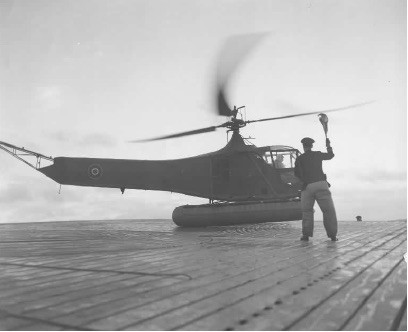
On November 23 a helicopter detail proceeded to Bridgeport to take part in the joint US-British ASW Evaluation Trials. The British SS Daghestan arrived the same day. Two helicopters were used – one British and one American. Weather was bad but improved by the 25th allowing for training flights in preparation for Phase 1. Among those observing was GEN Frank E. Lowe, Military Executive of the Special Committee Investigating the National Defense Program. He became an interested ally of Erickson. Phase one was essentially a repeat of the tests on the Bunker Hill. Phase two was conducted off Block Island. The most difficult condition under which operations were conducted was a wind of 42 knots over the deck, roll of four degrees, and a vertical deck movement of five feet. There were 328 landings made during this operation. The only major difficulty encountered was starting and stopping the rotor in high winds. Phase three consisted of operations from a vessel in convoy on the Atlantic crossing. The SS Daghestan sailed in convoy in January. Wind and sea conditions prevented any attempt at flight operations except for three days during the 16 day voyage. The ship’s roll was never less than 10 degrees and during the worst conditions the roll increased as high as 45 degrees. Wind gusts were as high as 80 knots. A 30 minute flight was conducted on 16 January by LT Stewart Graham USCG and a 30 minute flight was conducted by F/L Jack Cable RAF. Both pilots, and later the Board, concluded that helicopters could operate from ships at sea but the performance of the helicopters presently available was too marginal to be operated satisfactorily off merchants ships in convoy.
There still existed, however, a possible defensive ASW role. In March of 1943 LCDR George Synon USCG, working as a researcher, advised Kossler of a sound device created by DR. Harvey Hayes. The device was to be suspended from a cable and lowered into the water to search for submarines. The letter stated that this could possibly be operated from a helicopter. It was not followed up on at the time because there were only two helicopters in operation, both with limited capabilities. Evaluations were made using Lighter-Than–Air craft. This did not prove to be satisfactory and development stopped. In December of 1944 under the direction of LT. Roy Rather USN the earlier efforts of Dr. Hayes were reopened. Dr. J.J. Coop, who had earlier been involved, assisted. On 12 January the Vice Chief of Naval operations was directed to make available the Hayes equipment to the Anti-Submarine Development Detachment. Technical assistance was to be provided by the Bureau of Ships and the Naval Research Laboratory. The Coast Guard was directed to provide the helicopter and crew. This would later prove to be the thread that kept the development of the helicopter going and is covered in a later narrative in this Time Line.
The helicopter as a Rescue Vehicle
New and more powerful helicopters being developed would have been able to operate off the merchant ships but the submarine threat had decreased substantially and it was obvious the helicopters would not be ready to play an important ASW role during World War II. During the testing and evaluation program modifications had been made and the ability of the helicopter to take off and land vertically had been successfully demonstrated. Nothing, however, had been done to take advantage of the helicopter’s ability to hang motionless over a specific spot.
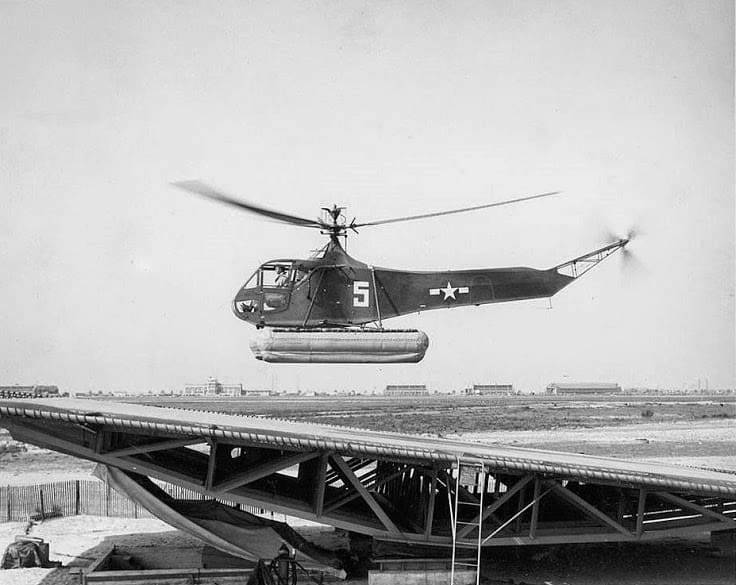 Preparations for the convening of a formal school to train pilots and maintenance personnel had continued through winter of 1943 and into the spring of 1944. LCDR O.R. Smeder USCG, in charge of ground school wrote most of the training manuals. Four additional Flight instructors had been trained and the first of 12 British Officers arrived 15 January. In May the Royal Navy flying School was set up at Brooklyn and would remain until 7 March 1945 when it transferred to the United Kingdom. A 40 by 60 foot landing platform that simulated landing conditions aboard ship by rolling five to ten degrees with a period of ten seconds became operational on 1 April. It was christened USS Mal de Mer. Soon actual landings were being made on the Cobb which had been specially equipped with a deck designed for this purpose. In addition a synthetic trainer, a flyable cockpit simulator, an effective training device ahead of its time, was designed and fabricated. Erickson formalized the flight curriculum and the first six week course began on 4 June. Kossler attended the first class and completed the course on 1 July.
Preparations for the convening of a formal school to train pilots and maintenance personnel had continued through winter of 1943 and into the spring of 1944. LCDR O.R. Smeder USCG, in charge of ground school wrote most of the training manuals. Four additional Flight instructors had been trained and the first of 12 British Officers arrived 15 January. In May the Royal Navy flying School was set up at Brooklyn and would remain until 7 March 1945 when it transferred to the United Kingdom. A 40 by 60 foot landing platform that simulated landing conditions aboard ship by rolling five to ten degrees with a period of ten seconds became operational on 1 April. It was christened USS Mal de Mer. Soon actual landings were being made on the Cobb which had been specially equipped with a deck designed for this purpose. In addition a synthetic trainer, a flyable cockpit simulator, an effective training device ahead of its time, was designed and fabricated. Erickson formalized the flight curriculum and the first six week course began on 4 June. Kossler attended the first class and completed the course on 1 July.
On 3 January, 1944 an event occurred that would provide the first test of a helicopter in an
emergency situation. The USS Turner, anchored off of Sandy Hook, New Jersey had an enormous explosion which was followed by a second 47 minutes later sinking the ship. The survivors were brought to the hospital at Sandy Hook. The weather was snow squalls and sleet, winds of 20 -25 knots and extremely reduced visibility, all airfields in the area were closed and blood plasma was needed. Admiral Parker called Erickson and asked if it was possible to pick up plasma at the Battery in New York and get it to Sandy Hook. Erickson answered “Yes.” and within minutes he, with Walter Bolton as co-pilot, was on the way. The visibility was so low that considerable care was exercised passing around the ships anchored in Gravesend Bay. Wind was blowing off the buildings at the pick up area creating a considerable amount of turbulence. Weight restriction was a problem and in order to facilitate the delivery of the plasma, Bolton reluctantly stayed behind. Erickson had to back the helicopter out on departure. It was evident that the weather conditions were such that no other type aircraft could have completed the mission. It was so noted in a New York Times editorial dated 6 January.
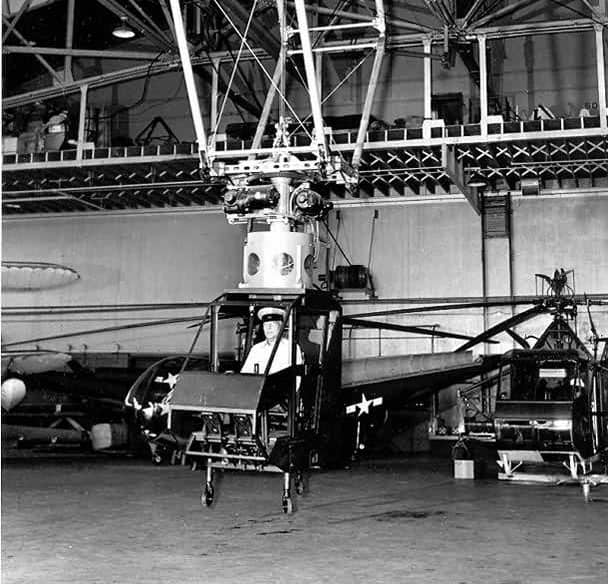
In April, when Admiral Waesche testified before the House Appropriations Committee in support of the Coast Guard’s procurement of helicopters he stated to the committee “The Coast Guard has been assigned the duty of carrying on extensive experimentation in connection with the use of helicopters, both aboard ship and at coastal stations in connection with both anti-submarine warfare and air-sea rescue operations.” This may have been a stretch at the time but it indicated that the Commandant was aware of the rescue capability evaluations that Kossler and Erickson were engaged in. This was the first official recognition of the search and rescue potential of the Helicopter.
To fully utilize the capabilities of a helicopter a method of lifting a person from peril while the helicopter was in a hover had to be developed. The first attempt was to devise a net suspended from the helicopter that would scoop a person out of the water. Tests showed that without a means to get the rescued person inside the helicopter the person scooped would be in the rotor wash and suffer the effects of hypothermia. Erickson proposed a modification to HO2S (R-5) helicopter in which the cabin would be widened to carry a stretcher case, doors that swung outward and up into the open position, and a motor driven hoisting unit. The problem with the plan was that he did not have an HO2S on hand. The only practical way to prove the hoist concept was to devise something simple that could be demonstrated on the HNS. A hoist boom and drum were connected to the rotary actuator and driven by a 12 volt motor with a high gear ratio. The cable had a pick up hook and harness. It worked well except the magnetic brake was apt to slip with a weight of over 200 pounds. The motor was changed to a Vickers hydraulic pump system permitting the hoisting of 400 pounds at a rate of two and one-half feet per second. The redesigned system worked perfectly.
The upgraded hoist system was installed at an opportune time. Captain Robert Dixon USN, the Director of Military Requirements, called Erickson inquiring about the hoist and asked if it could be demonstrated in a Navy Air Sea Rescue Exhibit Test Demonstration at the Naval Air station, Lakehurst on October 2, 1944. Erickson answered yes. This provided a weeks time to practice picking up people from rubber rafts. Arrangements were made for the use of the USCGC Cobb, which was equipped with a helicopter landing deck, as a base to carry out the tests. The Cobb anchored at Manasquan Inlet on the first and Erickson and Graham flew down to Lakehurst on the morning of the second. Not long after arrival RADM DeWitt C. Ramsey, Chief of the Bureau of Aeronautics, dropped by and looked over the rig. Just after 1300 Erickson and Graham flew out to the Cobb and spent the next several hours watching Navy rescue units demonstrate parachute drops, survival gear, and methods of egress from parachutes and aircraft after entering the water.
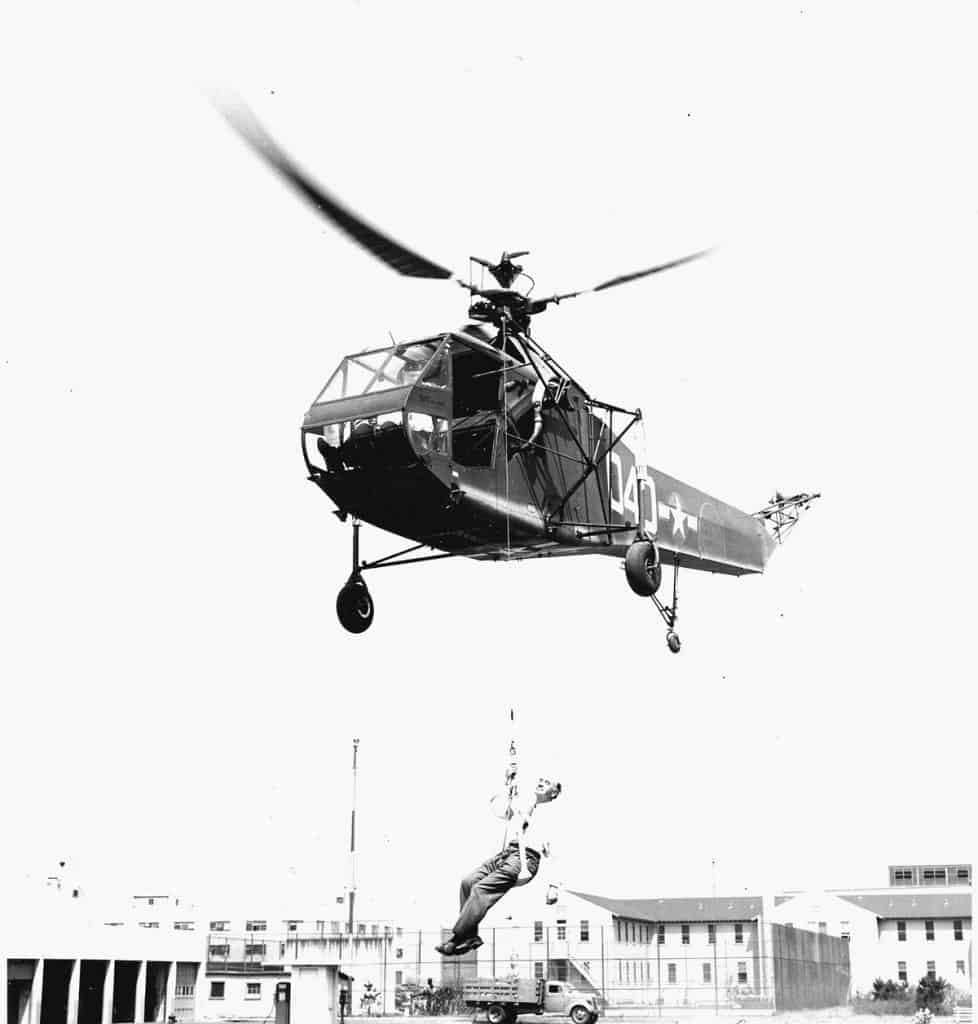
When it became time for the helicopter demonstration to start, four men wearing life jackets equipped with pick-up harnesses were put over the side in two rubber life rafts. Graham started the engine and when it had warmed up he took off and hovered 15 feet above the deck. He then hoisted a man up to the helicopter and lowered him to the deck testing the hoist and hovering performance of the helicopter. Seeing this, the observer boats all headed for the Cobb. Exactly on schedule at 1700 Graham flew off the ship and made a circle to approach the first raft from downwind. He hoisted a man up to the helicopter and returned to hover over the ship and lower the man to the deck. He repeated the routine for the other three men except for the last pick up during which he flew backwards from the ship to the life raft. All four pick-ups were completed in less than the ten minutes allowed. A rescue demonstration by a blimp followed the helicopter demonstration. They ran into troubles and required 45 minutes to lift one man from the water. The contrast between the helicopter and blimp was obvious. One man that was very much impressed was RADM Ramsey USN. From that day on the helicopter program had his unqualified support.
The Army Air Force was also impressed with the performance of the hoist and ordered twelve rescue hoists and visited the Coast Guard helicopter unit to copy details of the installation. The hoisting equipment was installed on the XHOS (R-6) and worked just as well. Sikorsky was impressed and submitted a proposal to the Army Air Force recommending this modification be made on all Army Air Force R-6s. The Army agreed. On 15 December RADM Ramsey conferred with Erickson to discuss the Navy helicopter program. He told Erickson he wanted all Navy helicopters equipped with hoists for rescue work. Erickson was directed to coordinate this with the Naval Aircraft Modification Unit at Johnsville, Pennsylvania.
Actual rescues continued and a number of different opportunities presented themselves to demonstrate the versatility and capabilities of the helicopter. The Brooklyn Navy Yard asked for the service of a helicopter one day a week for use in calibrating fire control radars on ships. It worked so well that the practice became common at other shipyards and would continue for several years. In October of 1944 an evaluation of the utilization of helicopters for spraying mosquitoes to control malaria was conducted.
The Coast Guard Helicopter Development Program Terminated
Events took place that led to the termination of the Coast Guard helicopter development and training program which had been established at Coast Guard Air Station Brooklyn.
In March of 1944 the Air Sea Rescue Agency was established when the Joint Chiefs of Staff requested the secretary of the Navy to establish an agency within the Coast Guard to conduct joint studies and assemble information on technical data, design of air sea rescue equipment, methods and techniques, and procedures including adequate facilities for air-sea rescue. The agency was to disseminate this information to appropriate agencies and maintain liaison with agencies of other nations. The Navy and the Army Air Force were to continue to provide search and rescue for their own operations. The Coast Guard was still part of the Navy at the time and was directed by the Navy to provide the men and material for search and rescue operations in the Continental Sea Frontiers. This function was carried out by the Coast Guard Office of Search and Rescue – not to be confused with the Air-Sea Rescue Agency. The number of authorized aviators was increased and fixed wing amphibians and seaplanes were provided. This was beneficial for the Coast Guard and solidified its claim to prominence in search and rescue operations. Many people involved in the search and rescue operation saw little or no benefit in the helicopter and some thought it to be detrimental.
Kossler and Erickson felt that just the opposite was the case. They strongly believed that the future of Coast Guard rescue operations involved having helicopters placed at small stations up and down the coasts, supported by air stations, and working in conjunction with Coast Guard cutters and lifeboats. Both men were visionaries that possessed the capabilities to turn a vision into reality and they did it well. Erickson was willing to assume authority, was direct and totally dedicated to the development of the helicopter. He was able to convince many of the value of the helicopter. These same traits would come to alienate those within the Coast Guard aviation establishment that he was not able to convince.
Senator Meade and two members of the Helicopter Subcommittee, senators Harley Kilgore and Homer Ferguson inspected the facilities on 17 February. They reported that they were pleased with the progress being made with the helicopter but time was running out for the helicopter program. With the end of the war in sight the large orders for helicopters were cancelled. Kossler was again in poor health and requested the Commandant transfer the helicopter program into regular channels. Headquarters aviation staff saw no use for the helicopter in the Coast Guard ASR operations and steps were taken to discontinue operations. Training classes at the school were canceled except for Navy personnel that would commission and operate the first Navy helicopter squadron. The majority of the helicopters were put in storage. The landing platform and training simulator were scrapped. Only enough helicopters were kept in service for the limited amount of training; the radar calibration flights that had been set up with the Navy for the ship yards at Boston, New York and Philadelphia: and the XHOS-1 which was scheduled for the testing of the Hayes sonar equipment as per direction of the Vice Chief of Naval Operations.
CDR Arthur J. Hesford USCG relieved Erickson as Commanding Officer of Coast Guard Air Station Brooklyn in March. Erickson was not transferred as is customary with relieved commanding officers nor was he reverted to executive officer or any other position in the chain of command. Erickson located in a small office and continued with the sonar project assigned by the Navy with little interference. It was not the best of circumstances for either Hesford or Erickson. Hesford was considerate and it was reciprocated. However, the relationship between Erickson and the headquarters staff is best described as acrimonious.
Erickson Continues
Erickson had been relieved; he had no command; but he still had the CNO’s letter of 15 February 1943 ordering the development of the ASW helicopter. In January of 1945 LT Roy Rather USN and project engineer DR J.J. Coop reopened the earlier effort in developing underwater sound detection equipment. Within two months they believed they had the earlier problems solved and had a unit ready to install on a helicopter. During this period Erickson accepted a new XHOS-1. Rather and Coop arrived at Floyd Bennett Field early in March, ready to begin the tests.
Dr. Coop had been successful in eliminating the very high static noise of previous tests and the mechanical defects in the attachment of the Sonar head. The sound
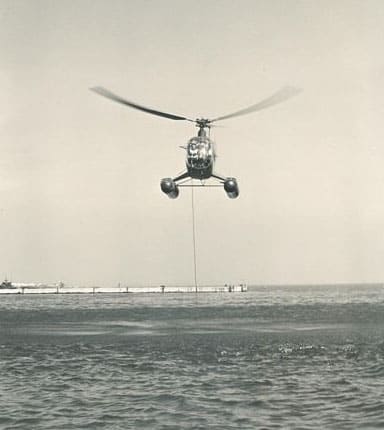
equipment was installed in the XHOS after modification of its small cabin to accommodate all components. Erickson suggested the helicopter sonar test be conducted from the Coast Guard Cutter Cobb. In mid April Erickson, Lt. Stew Graham, and others boarded the Cobb for the test area off Block Island, Long Island Sound. Erickson and Graham took turns piloting the helicopter with Coop and Rather alternating as sonar operators. To obtain Sonar readings the helicopter had to hover over one spot and keep the suspended sonar cable vertical while dipping the transducer below the water’s surface. In order to do this a reference on the water was required. Float lights and dye markers were tried but the helicopter downwash swept both away. Surprisingly a sheet of the Sunday newspaper colored comics was found to soak up enough water and not blow away and could easily be seen from an altitude of 25 feet. While okay for these early tests an instrument was developed to tell the pilot when the cable was vertical.
The results of the tests proved that the Sonar equipment was sufficiently effective in locating and tracking the target submarine to warrant further development. Dr. Coop and his assistant redesigned the Sonar’s electrical components and in January of 1946 the testing continued in Jamaica Bay and then at Key West, Florida.
Note: The further tests and ASW operations of helicopters is presented in this section under the heading; 1946 – Post War Helicopter Development.
The rescue capability of the helicopter was again displayed at the end of April. On 19 April a Canadian PBY-5A had been forced down 180 miles south of Goose Bay, Labrador. Two men were badly burned when the PBY caught fire after crashing in the wilderness. Several days passed before a USAAF C-47 spotted their distress signal. Two RCAF Norseman ski-equipped planes dispatched to the scene landed safely. One crashed on take off after taking aboard survivors. No injuries resulted. One managed to take off with the two burned survivors. A blizzard prevented any further attempts during the next two days. When the weather cleared, the Norseman returned and landed, but when the takeoff was attempted the skis became bogged down in the mushy snow and they could not take off with any survivors aboard. Both were stripped to reduce weight and later flown out without survivors. Rescuers anticipated the nine men left behind would be stranded for weeks until the lakes thawed sufficiently for float planes to land.

The answer was the helicopter. The XHOS was loaded with sonar equipment and involved in the sonar testing. However, Erickson still had an operable HNS. Though lacking in range, and capable of carrying only one passenger, it was disassembled, loaded on an Army Air Force C-54 and flown to Goose Bay, arriving on the twenty-ninth. Working continuously the crew had it reassembled by the morning of the thirtieth. That morning Lt. August Kleisch, USCG, departed in the float equipped helicopter, burdened with seven five-gallon cans of gasoline lashed to the floats, for the 184-mile trip to Lake Mecatina via the survivor’s camp. Kleisch, escorted by a Canadian PBY, landed about midway on the flight, refueled the helicopter from the gas cans and departed for the survivor’s camp. The plan was to fly the survivors to the Mecatina radio range station located on an island in the middle of Mecatina Lake. This was 32 miles distant from the crash site and served as the base camp. Gasoline was available there. With a helicopter that flew the trip at 50 miles per hour only one man was evacuated on the first day. Kleisch continued the next day. The last survivor came out three days and nine round trips later on the afternoon of 2 May. The survivors were
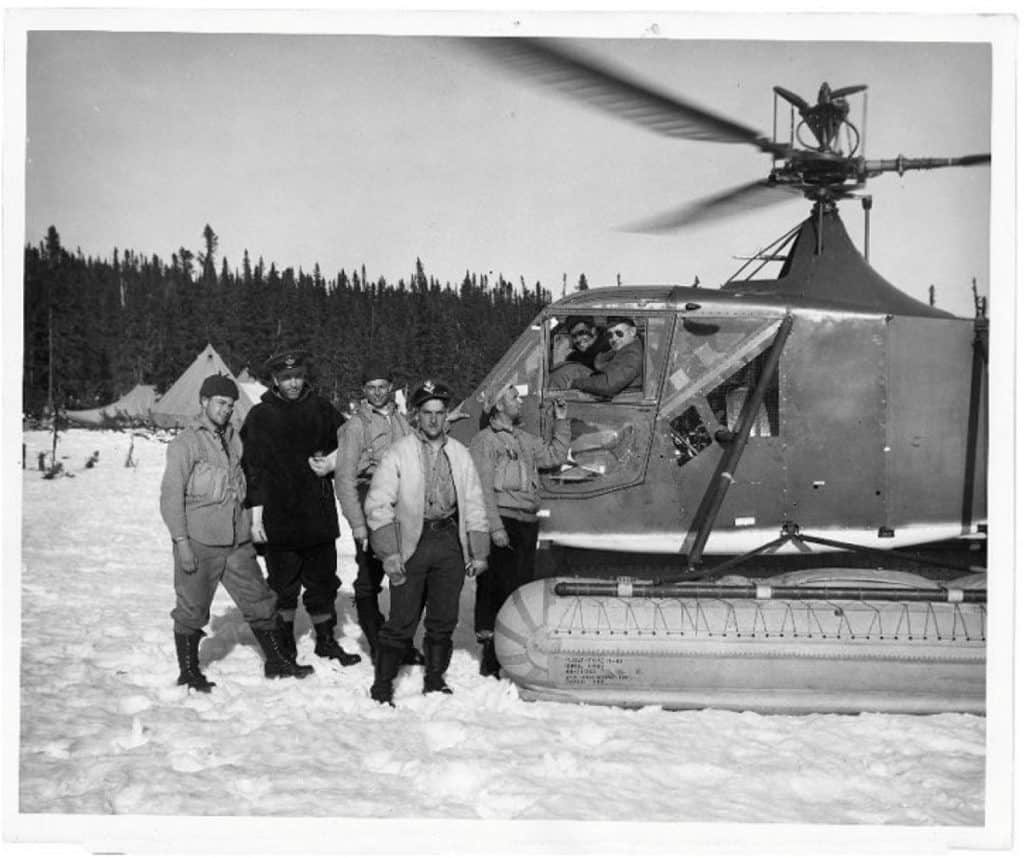
flown from the base camp to Goose Bay.
News of this remarkable feat spread and even with a war on it captured the public’s interest. Gen Lowe dropped by to see Erickson within days of the rescue bringing with him General Jacob L. Devers, US Army, for a helicopter demonstration. Devers had just returned from Europe to take command of the Army Field Forces. Erickson tailored his demonstration to his audience. The Army, moving ahead, assigned R4s to Liberty ships with landing platforms designated as Aircraft Repair Units in the Pacific.
On 1 May Lt. Carter Harmon USA in an R-4 (HNS-1) made the first Combat SAR helicopter pickup behind Japanese lines in Burma.
Erickson continued to promote the helicopter to all that would listen. In 1946 Erickson and a small dedicated group moved to a location on the Elizabeth City air station to continue development work.

